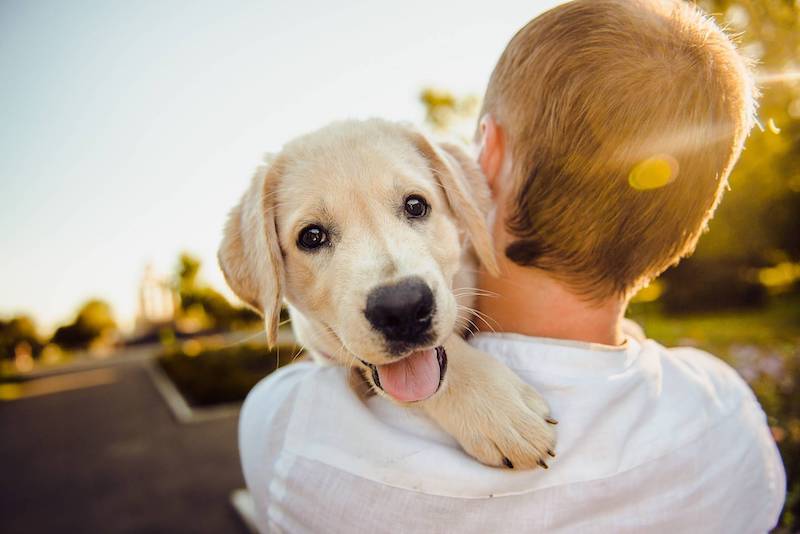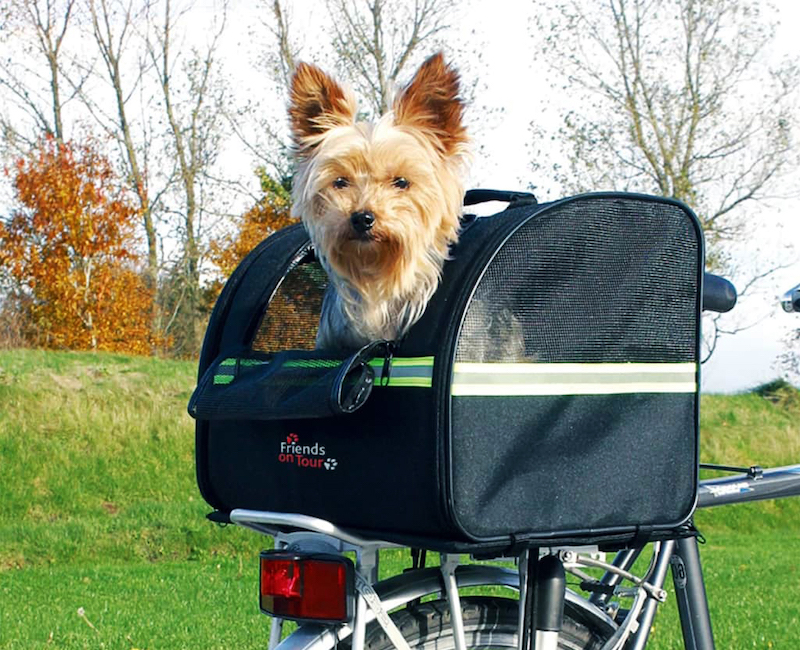Contrary to what you might think, not all dogs enjoy being carried. Especially since many dog owners adopt the wrong technique for holding their pets. Find out the mistakes not to make and the best way to keep a dog!
Why and when you need to carry your dog?
There are many reasons and different instances why you need to carry your dog and when you should do it. In fact, carrying a dog is not advisable at all times unless you have a very small dog and you are riding the bus or subway. So when to carry a dog and why?
- If the dog is ill and you have to bring him to the veterinarian
- If you are traveling with your Chihuahua and she is inside your dog backpack or a dog bag
- If he is extremely tired after a very long walk
Even in dire situations like during the time of rescue, picking a dog from the water when it’s drowning is not advisable as he may become aggressive. There are other ways to do it instead of using your bare hands.
Nevertheless, if you are dealing with your own dog, you need to know the following:

The right technique for carrying a dog
First of all, if you want to hug your dog and give him a hug or take him somewhere, don’t suddenly jump on him. Imagine someone rushing straight at you and lifting you off the ground without warning, that wouldn’t be very pleasant, would it? The same goes for your furball!
To avoid the surprise effect, use a verbal command (“Hug” for example) that you give your dog each time you hug him. Once the order has assimilated to the gesture, your pet will know that when you give it this order, you are about to carry it.
Now find out how to carry a dog based on its size:
- For a small dog (less than 10 kilos): slide an arm under its chest, between its front legs. Then, as you lift him up, support his buttocks with your other arm.
- For a medium-sized dog (between 10 and 20 kilos): place one arm behind its hind legs and wrap your other arm around its chest. Then hold it against your chest.
- For a large dog (over 20 kilos): same as for a medium-sized dog. Ideally, one person should lift the animal’s chest and another its hindquarters.
5 mistakes not to make when carrying your dog
Now that you know how to properly carry your dog, there are some things your pooch would still like you to know when you lift him off the ground.
1. Lift it by the skin of the neck
We tend to think that dogs don’t feel anything when lifted by the skin of the neck. Indeed, their mother did it well when they were puppies …
In fact, lifting a dog this way is strongly discouraged for the simple reason that it can be uncomfortable for him or even painful.
2. Lift him by his collar
It might sound obvious, but some dog owners, especially children, don’t necessarily think about it. Lifting a dog by holding it by its collar is like taking its breath away and strangling it, quite simply.
In addition, it can cause permanent damage to his trachea or even his larynx …
3. Lift it by the tail
The tail is an extension of your dog’s spine. It seems that this simple sentence is enough to explain that pulling him by the tail could cause serious injury.
4. Lift it up by the front legs or armpits.
Your dog’s front legs are designed to make him run and jump at top speed, but they are absolutely not designed to support his weight when suspended in the air.
For this reason, do not lift it by the armpits or front legs, like a doll. This could not only be painful for him but also put a strain on his muscles and ligaments. Worse, you could even dislocate a shoulder or an elbow …
5. Not recognizing the signs of discomfort
Just because your dog isn’t yapping doesn’t make him feel good. To express his discomfort, even his anxiety, he has other more subtle ways: he struggles, licks his chops, looks away, yawns …
If you notice one or more of these behaviors in your dog while you are carrying it, immediately put it back on the ground.

Traveling far? Use a dog backpack
Backpack for the dog, belly bag for the dog, shoulder bag for dog… There is an almost endless choice of bags to carry your small dog. From hiking bags to super fashionable bags, there is something for all tastes and for all prices. Usually, I test the accessories I tell you about with my dog. Musher being a Labrador, it was impossible for me to test for myself so I relied on feedback from my friends who use these kinds of accessories for their dogs. When I think about it, thanks to their bag, their dog is allowed to follow them almost everywhere: visiting a museum, a castle, taking the bus… Their dog jumps in the bag and the problem is solved. If only I could do the same with Musher. When will you see XXL-size bags?
Why choose a transport bag for your dog?
The backpack or the dog carrier bag, whatever its shape is intended for small dogs, weighs less than 10 kilos as a rule, although some bags can carry dogs a little bit heavier. If the bag you choose is resistant to heavier loads, make sure your back will be able to carry that weight a certain distance. This is a real question to ask yourself before ordering a dog backpack …;) Chihuahua, Yorkie, pinscher, spitz … are breeds often used to traveling in bags.
Dog carrier bags are useful for:
- puppies who do not have to walk much during their growth period,
- senior dogs who tire quickly and can no longer follow you as before in all your activities. On this subject, I invite you to read or reread the article Traveling with a senior dog, you will find lots of tips and advice for you and your animal.
- sick dogs who will find in this dog backpack an ideal comfort ally
- dogs not very athletic, able to follow you on short walks, but who have difficulty following you on long hikes, for example. They will be delighted to share the adventure while having the opportunity to take a little rest comfortably behind your back.
- stop carrying your dog at arm’s length as soon as he gets a little tired or the ground is too hot in summer, for example.
Being able to carry your dog in a dog backpack or something else is also to ignore the famous “forbidden dog”. Usually, you will be allowed through if your dog is quiet in his bag. Believe me, all happy owners of medium or large dogs would dream of being able to take their dog on board in a bag to nail down all its prohibitions. I will dream of arriving in front of a museum, a cafe, or a “dog prohibited except those who fit in a bag” castle, unfolding my bag and blowing Musher into it! I can already imagine the heads of people at the checkout … The bag can be a great solution for the holidays with your dog. It might be easier to take it everywhere with you!
Contrary to what you might think, not all dogs enjoy being carried. Especially since many dog owners adopt the wrong technique for holding their pets. Find out the mistakes not to make and the best way to keep a dog!
Why and when you need to carry your dog?
There are many reasons and different instances why you need to carry your dog and when you should do it. In fact, carrying a dog is not advisable at all times unless you have a very small dog and you are riding the bus or subway. So when to carry a dog and why?
- If the dog is ill and you have to bring him to the veterinarian
- If you are traveling with your Chihuahua and she is inside your dog backpack or a dog bag
- If he is extremely tired after a very long walk
Even in dire situations like during the time of rescue, picking a dog from the water when it’s drowning is not advisable as he may become aggressive. There are other ways to do it instead of using your bare hands.
Nevertheless, if you are dealing with your own dog, you need to know the following:
The right technique for carrying a dog
First of all, if you want to hug your dog and give him a hug or take him somewhere, don’t suddenly jump on him. Imagine someone rushing straight at you and lifting you off the ground without warning, that wouldn’t be very pleasant, would it? The same goes for your furball!
To avoid the surprise effect, use a verbal command (“Hug” for example) that you give your dog each time you hug him. Once the order has assimilated to the gesture, your pet will know that when you give it this order, you are about to carry it.
Now find out how to carry a dog based on its size:
- For a small dog (less than 10 kilos): slide an arm under its chest, between its front legs. Then, as you lift him up, support his buttocks with your other arm.
- For a medium-sized dog (between 10 and 20 kilos): place one arm behind its hind legs and wrap your other arm around its chest. Then hold it against your chest.
- For a large dog (over 20 kilos): same as for a medium-sized dog. Ideally, one person should lift the animal’s chest and another its hindquarters.
5 mistakes not to make when carrying your dog
Now that you know how to properly carry your dog, there are some things your pooch would still like you to know when you lift him off the ground.
1. Lift it by the skin of the neck
We tend to think that dogs don’t feel anything when lifted by the skin of the neck. Indeed, their mother did it well when they were puppies …
In fact, lifting a dog this way is strongly discouraged for the simple reason that it can be uncomfortable for him or even painful.
2. Lift him by his collar
It might sound obvious, but some dog owners, especially children, don’t necessarily think about it. Lifting a dog by holding it by its collar is like taking its breath away and strangling it, quite simply.
In addition, it can cause permanent damage to his trachea or even his larynx …
3. Lift it by the tail
The tail is an extension of your dog’s spine. It seems that this simple sentence is enough to explain that pulling him by the tail could cause serious injury.
4. Lift it up by the front legs or armpits.
Your dog’s front legs are designed to make him run and jump at top speed, but they are absolutely not designed to support his weight when suspended in the air.
For this reason, do not lift it by the armpits or front legs, like a doll. This could not only be painful for him but also put a strain on his muscles and ligaments. Worse, you could even dislocate a shoulder or an elbow …
5. Not recognizing the signs of discomfort
Just because your dog isn’t yapping doesn’t make him feel good. To express his discomfort, even his anxiety, he has other more subtle ways: he struggles, licks his chops, looks away, yawns …
If you notice one or more of these behaviors in your dog while you are carrying it, immediately put it back on the ground.
Traveling far? Use a dog backpack
Backpack for the dog, belly bag for the dog, shoulder bag for dog… There is an almost endless choice of bags to carry your small dog. From hiking bags to super fashionable bags, there is something for all tastes and for all prices. Usually, I test the accessories I tell you about with my dog. Musher being a Labrador, it was impossible for me to test for myself so I relied on feedback from my friends who use these kinds of accessories for their dogs. When I think about it, thanks to their bag, their dog is allowed to follow them almost everywhere: visiting a museum, a castle, taking the bus… Their dog jumps in the bag and the problem is solved. If only I could do the same with Musher. When will you see XXL-size bags?
Why choose a transport bag for your dog?
The backpack or the dog carrier bag, whatever its shape is intended for small dogs, weighs less than 10 kilos as a rule, although some bags can carry dogs a little bit heavier. If the bag you choose is resistant to heavier loads, make sure your back will be able to carry that weight a certain distance. This is a real question to ask yourself before ordering a dog backpack …;) Chihuahua, Yorkie, pinscher, spitz … are breeds often used to traveling in bags.
Dog carrier bags are useful for:
- puppies who do not have to walk much during their growth period,
- senior dogs who tire quickly and can no longer follow you as before in all your activities. On this subject, I invite you to read or reread the article Traveling with a senior dog, you will find lots of tips and advice for you and your animal.
- sick dogs who will find in this dog backpack an ideal comfort ally
- dogs not very athletic, able to follow you on short walks, but who have difficulty following you on long hikes, for example. They will be delighted to share the adventure while having the opportunity to take a little rest comfortably behind your back.
- stop carrying your dog at arm’s length as soon as he gets a little tired or the ground is too hot in summer, for example.
Being able to carry your dog in a dog backpack or something else is also to ignore the famous “forbidden dog”. Usually, you will be allowed through if your dog is quiet in his bag. Believe me, all happy owners of medium or large dogs would dream of being able to take their dog on board in a bag to nail down all its prohibitions. I will dream of arriving in front of a museum, a cafe, or a “dog prohibited except those who fit in a bag” castle, unfolding my bag and blowing Musher into it! I can already imagine the heads of people at the checkout … The bag can be a great solution for the holidays with your dog. It might be easier to take it everywhere with you!







